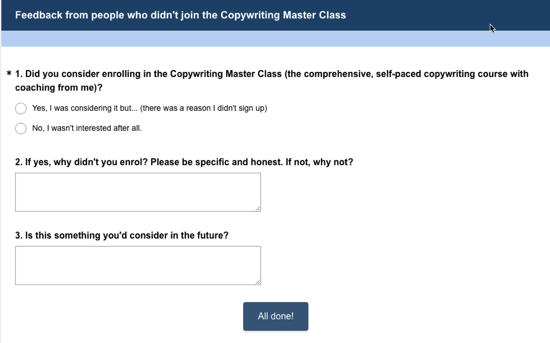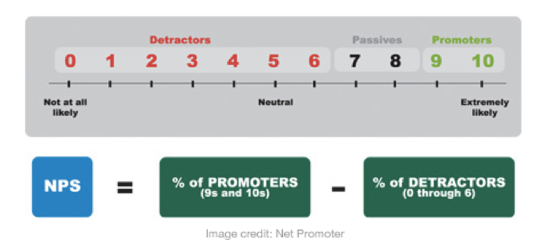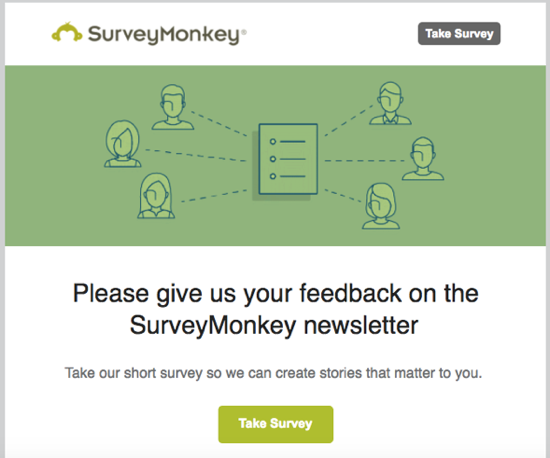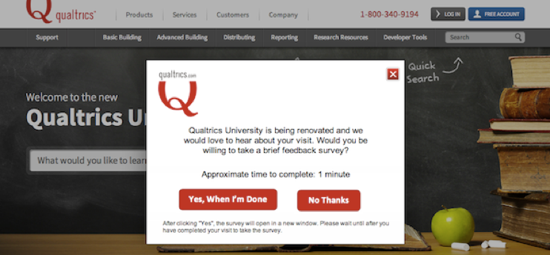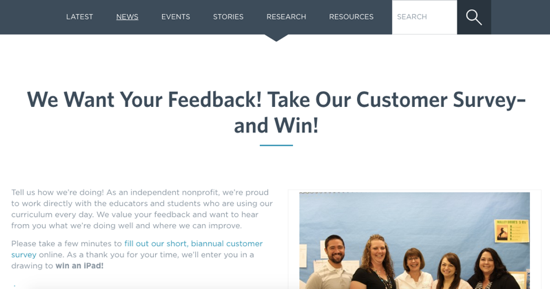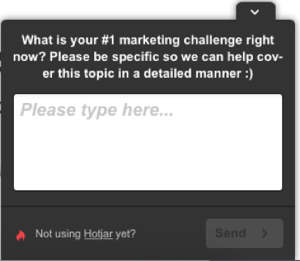How to use surveys to get valuable feedback from your customers
Good or bad, every one of your customers has an opinion about your business. They judge everything, from how easy it is to navigate through your site and buy a product to how long it takes you to reply to their email enquiry. These experiences and interactions with you affect their perception of your business, which they share online (and offline!) with their friends, many of whom can be your next customers.
But here’s the thing: while every customer has an opinion, very few voice it to the company. In fact, only one out of 26 unhappy customers complain. Those who remain silent, simply leave and take their business elsewhere. This is a stat you can’t afford to ignore.
Many businesses mistakenly assume that silence or the absence of feedback is a sign of satisfaction, and then they’re left wondering why they lose so many customers. That’s why it’s so important to proactively seek feedback from customers.
In this article we’ll look at different ways of carrying our surveys, depending on your budget and the channels your customers are using most.
But first…
Why are surveys important?
These days it’s incredibly easy for customers to share their feedback and experiences online, whether it’s on social networks like Facebook and Twitter, on forums or on review boards like TrustPilot, Yelp!, or Angie’s List.
They’re also not shy about sharing negative experiences either. Research shows that 45% of customers turn to social media to share negative reviews.
But here’s the problem. As a business, you need to keep a close eye on any mention of your brand on social networks and review sites if you want to maintain your online reputation. You need to review everything that’s being said about you, and then respond to all comments, good or bad.
But even with the plethora of tools that make it easier to monitor mentions of your brand, you still can’t get a complete picture of customer sentiment. Why? Because a 2-star rating and a generic “Your website/ product/ service/ customer support is terrible” message don’t offer much insight into what went wrong and what you can do to improve.
That’s why asking for feedback, as opposed to waiting to receive it, is crucial.
So now that you know why survey are so important, let’s look at the different types of surveys and questions that you can ask customers to get valuable, actionable feedback.
Types of surveys
The first step to creating and sending a survey is deciding what it’s for.
When thinking about surveys, usually the first question that comes to mind is this: “How happy are my customers?”.
Sure, you want to make sure your customers are happy. Every business does. But the problem with this is that this question is too broad, which means you won’t be able to get too much useful information out of it.
So our advice is to go with surveys that are tied to specific goals. Are you considering launching a new product and want to see if there’s any interest in it? Are you trying to figure out what additional services you could provide to customers and the fair price to charge? Want to know what people think about your customer support or about your website redesign?
Knowing what the results are going to be used for will make it much easier to put together a survey that will give you the answers you’re looking for.
Here’s a look at some standard customer surveys:
Product satisfaction surveys: When you have a complex product that your customers may find confusing or difficult to use, the customer experience quickly sours. That’s why it’s important to measure product satisfaction post-purchase to find out about customer’s experience using your product. This allows you to make changes and maybe create extra documentation and resources to make customers’ lives easier.
Customer satisfaction surveys: You’re probably familiar with this common survey type. These have long been used to measure customer happiness and to determine potential issues that might make customers unhappy. When you understand how your customers feel about specific aspects of your business, like customer support or delivery, you can identify which issues need to be addressed quickly.
Prospect surveys: Surveys aren’t only for people who have already purchased something from you, but also for those who are considering becoming customers. So these types of surveys can help you determine whether there’s an opportunity to sell, or what’s preventing someone from buying from you. Is price an objection? Or maybe your site doesn’t look trustworthy?
Here’s a simple example:
Net Promoter Score surveys: This type of survey uses one primary question (How likely are you to recommend our business?) to measure overall customer satisfaction and loyalty. It’s perfect for benchmarking customer loyalty and gathering feedback at each stage of the customer journey.
When you’ve figured out what your survey is for, it’s time to start thinking about which questions you’re going to ask.
Questions to ask
Every question needs to serve a purpose. So make sure each survey focuses on a specific aspect of your business that you’d like to improve and ask questions around that. It’s the only way to get actionable data that can help improve your business.
Now, many businesses get poor results when they send out surveys. Either very few people complete the survey or the responses are just not helpful. But that doesn’t have to happen to you.
If you want get great responses, here are a few things to keep in mind when creating a survey:
- Keep it short and simple. When was the last time you sat around and excitedly answered a 30-minute survey? Probably never. So if you want to have as many people as possible take your survey, keep it short, clear and concise.
- Ask only questions that have a purpose. Be ruthless when it comes to cutting unnecessary questions from your survey. If you’re not going to use the information you’re asking for, you’re wasting your customer’s time, as well as yours. For example, if your survey is about finding out whether customers believe your prices are too high, it makes no sense to ask how they feel about your website design, does it? Also, do you need to know a customer’s complete name or location? If not, don’t ask.
- Use open-ended questions. While yes/ no and multiple choice questions or scales are useful and easier to answer, open-ended questions are those that will give you the most insight. It’s where customers spill their real thoughts so make sure you use them.
For more tips and advice on which questions to ask, these resources should come in handy:
10 essential tactics for creating valuable customer surveys
Surveys 101: A simple guide to asking effective questions
When your survey is complete, the next thing you’ll need to figure out is where you want to make it accessible.
Different ways of carrying out surveys
Depending on your business, your budget, and your target audience, there are different ways of carrying out surveys. So next we’ll look at various options so you can decide which ones would work best for you.
Emailing or sharing the link to the survey
There is no question that email is one of the easiest and most valuable ways to gather candid customer feedback. It’s what we’re most familiar with.
With tools like SurveyMonkey and Google Forms you can easily create and mail out surveys to your customer list.
Emailing your surveys is always a good option but keep in mind that you do need to have a mailing list of customers. So if you’re just starting out and haven’t yet built a list of customer emails, you might want to try other options instead, which we’ll outline later in the article. (You should also give some sort to building an email list so you can use it for future surveys. If you want to learn how, then check out our free email marketing course here.)
Now, there are pros and cons to emailing your surveys:
Pros
- It’s cheap. Google Forms is free, while SurveyMonkey is free for up to 100 responses.
- You don’t need technical knowledge to create and send your survey, or to gather responses.
- You can choose which people to send the survey to. For example, if you want to get feedback from people who have submitted an enquiry via your contact form but haven’t made a purchase, you can send your survey only to that group.
- You can review feedback in real-time.
Cons
- Low response rate. People have work to do, children to raise, friends to hang out with. Who has time to answer your questions? But they might make time if you offer an incentive in exchange for their honest feedback. This can be anything from a free gift card, a trial or the chance to be one of the few people to test you new product.
- Delay in responding. Since people have complete autonomy as to when they choose to fill out your survey, the responses might be slow in coming, which might delay your entire project. Mentioning a deadline at the beginning of the survey can help speed things up.
There are also other places where you can share the link to your survey, such as:
- On your website in a pop-up
You can do this with SurveyMonkey as well. This option is very useful if you don’t yet have a mailing list but are getting a decent amount of traffic to your website.
- On social media networks like Twitter and Facebook
Hey everyone! We want to know what we should focus on next. Please take a moment to answer our Easter survey:https://t.co/WILZQK94hV pic.twitter.com/rO9MZs6EDh
— CONAN EXILES (@ConanExiles) April 8, 2017
Why not take advantage of your social media presence to share a link to your survey and ask your fans and followers to fill it out?
- In a blog post or news piece
Use that blog traffic to let readers know about the survey you’re conducting. Give as much information as you want and make it enticing to compel more people to take the survey.
- As part of a confirmation email, along with your digital product or receipt
This is a good option if you’re looking to get feedback on a customer’s purchasing experience. Was it easy/ difficult to purchase a product? Did they encounter any problems? Or maybe you want to know why they chose that product and how they’re planning to use it.
Using social media
Comments, mentions and reviews aren’t the only ways for your business to get valuable feedback from your social media following.
You can also be proactive and ask your questions directly on the social channels where your audience is spending time online.
Consider this quick poll conducted on Facebook:
In this case, a short poll on a popular social network makes sense. While it’s too short to create a survey and email it, a one-question poll on social media can not only give you the answers you need (and quickly) but it can also get people more involved with your page. You can create a Facebook poll here.
The downside to asking questions on social media is that you have no control over who is answering. You might only be interested in answers from a specific age group or location. So only use polls on social media when you have a short, general question, and when the demographics of the sample is of little significance.
Using your website
Another option is to offer a survey right on your site, like in this example:
This is a bottom right corner popup that acts as a survey. It’s a good option if you want to ask visitors one or two questions that are relevant to the page they’re on. For example, you might want to find out if they’re finding all the information they’re looking for or if there’s any other feature they’d like included in your product.
These types of pop-up surveys are great for generating responses from users who are active on your website. Just keep in mind that they only work if they’re short (two questions tops) and if they don’t interrupt a user while they’re browsing the page. Also, use them with caution as most users find pop-ups frustrating so you risk driving them away.
If this is an option you’re interested in, you can also use SurveyMonkey to create pop-up surveys and add them to your website.
Follow up and take action
Ever wonder why so many people don’t complain, leave feedback or fill out surveys? Most likely it’s because they don’t think that the business cares or that it will do anything about it.
How many times have you shared your feedback with a business only to get a generic “Thank you. We’ll take that into consideration” followed by… zero action.
While it’s important to acknowledge every participant’s feedback and thank them for taking time out of their busy schedules to share their thoughts and opinions, it’s not enough. You also need to act on it. Otherwise every survey that you send is a waste of time.
If a customer speaks up about a problem, chances are others are experiencing it too. But apologising and moving on isn’t an option. If you want to prove that you’re truly listening to your customers, you have to show them that their voice matters.
This means asking the right questions, gathering all that valuable feedback and making the necessary changes to create a great user experience for everyone who visits your site and interacts with your business. By collecting the right information and acting on it, you’ll increase the chances that customers will keep doing business with you.
Any questions? Tweet us @123reg and we’ll do our best to help you make surveys work for your business.

